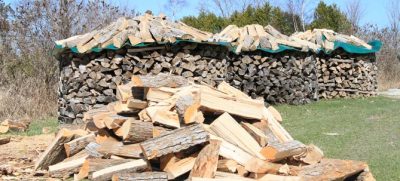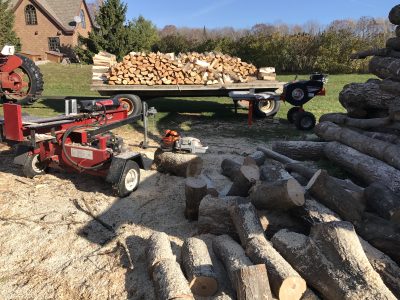How to Split Wood With a Log Splitter
Posted on
By: Steve Maxwell
Updated on July 8th, 2021

Canadian economist Jeff Rubin has a book that everyone should read, especially if you cut your own firewood. It's called Why Your World Is About to Get a Whole Lot Smaller. In it Rubin makes a well-supported case for the end of crude oil as a viable energy source for powering our world. That's a pretty radical claim – with huge implications – but Rubin cites fact after verifiable fact that all point in the same direction. Whether or not you heat your home with oil, natural gas, or electricity, rising crude oil demand and dwindling supplies will have an impact on you. It already is having an impact. This is one reason I cut and split firewood for heating at my place. It can save a ton of money for anyone with access to logs, and though making your own firewood isn't an option for everyone, a unique wood splitter I came across in 2011 makes the job much faster for those of us with an interest and aptitude for the work.
The hardest part of making firewood is splitting logs lengthwise after cutting blocks to length. Splitting makes wood small enough to handle easily, and it also opens up the bark for better drying. Traditional hydraulic wood splitters make the job of preparing firewood easier, but they don't necessarily make it happen faster. A good splitting axe and a pair of strong arms can produce firewood as fast as a traditional hydraulic splitter when you've got straight-grained logs, though a completely different kind of splitter has changed the wood splitting game.

Back in 2011, I began using the DR RapidFire 6HP Log Splitter (www.drpower.com; 800.687.6575) side by side with my 12 HP, 34 ton Swisher hydraulic splitter in a comparison test. The Swisher is an amazing strong splitter. I've never seen a log it couldn't split, not matter how wonky and gnarly the grain. The RapidFire, by contrast, isn't as strong, but it is at least twice as productive as my big hydraulic machine, all else being equal. It's also lighter and uses about 70% less fuel for a given amount of wood split.
The big boost in efficiency comes from the fact that the RapidFire completes each split cycle in about two seconds, instead of the usual 10 or 20 seconds required for each hydraulic split. Instead of a pump delivering hydraulic oil to a cylinder through hoses, seals and fittings, the RapidFire uses nothing more than a pair of spinning 75 lbs cast iron flywheels. Flipping a lever engages a rack and pinion gear mechanism, harnessing the inertia of the flywheels to push the log forward into the stationary wedge, splitting the wood. Release the lever and a spring pulls the mechanism back in a couple of seconds, ready for the next log. You have to see this kind of speed to believe it. It's amazing. Click to watch the video below to see for yourself. My older boys always dreaded splitting wood with me because they found the job so boring. They tell me the RapidFire is actually fun to use because it's so productive. The speed of progress makes it easier to forget the time.
Click below to watch the video:
There were two things that I wondered about before using the RapidFire:
- Is this machine as powerful as my hydraulic splitter?
- How long will the rack and pinion gear last since the teeth just clunk together without any kind of a clutch every time you begin a split cycle?
Although this machine can't handle the really big, knotty monster logs, the RapidFire breezes through almost every piece of hardwood I've put onto it. Sometimes I have to take several runs at a moderately tough log before the split gets completed, but speed is still way beyond my Swisher. In less than an hour of splitting I can make all the wood I need to heat my house, workshop and domestic hot water for a week of the coldest winter weather. We stack wood in round piles, not square, because the results happen faster and better. Click here for a detailed tutorial on how we stack round wood piles here at our place.

If Jeff Rubin is right, and crude oil becomes too expensive to remain the premier energy source for powering our world, then heating with wood certainly won't insulate you from all the effects. That said, isn't there still something valuable about being able to heat your home and domestic water in a self-reliant way that's completely outside the uncertainty and rising prices of international marketplaces? And for those of us who like to combine time outdoors with exercise that also produces something worthwhile, the firewood lifestyle is one of the big blessings that many regions of the world offers.
How to Split Wood With a Log Splitter
Source: https://baileylineroad.com/log-splitter/
0 Response to "How to Split Wood With a Log Splitter"
Post a Comment